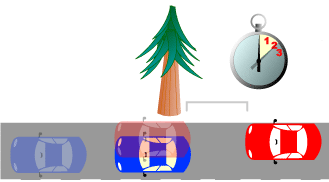Two-second rule

The two-second rule (also known as the three-second rule in some states) is a rule of thumb by which a driver may maintain a safe following distance at any speed.[1][2] The rule is that a driver should ideally stay at least two seconds behind any vehicle that is directly in front of the driver's vehicle. It is intended for automobiles, although its general principle applies to other types of vehicles.
The two seconds is not a guide to safe stopping distance. It is more a guide to reaction times.
The two-second rule is useful as it can be applied to any speed. It is equivalent to one vehicle-length for every 8 km/h (5 mph) of the current speed, but drivers can find it difficult to estimate the correct distance from the car in front, let alone to remember the stopping distances that are required for a given speed, or to compute the linear equation on the fly. The two-second rule gets around these problems, and provides a simple and common-sense way of improving road safety.
The practice has been shown to considerably reduce risk of collision, and also the severity of an accident, if an accident occurs. It also helps to avoid tailgating and road rage for all drivers.
The risk of tailgating is largely caused by the accident avoidance time being much less than the driver reaction time. Driving instructors advocate that drivers always use the "two-second rule" regardless of speed or the type of road. During adverse weather or hazardous conditions such as black ice, it is important to maintain an even greater distance of three or four seconds.
The two-second rule tells a defensive driver the minimum distance needed to reduce the risk of collision under ideal driving conditions. The allotted two-seconds is a safety buffer, to allow the following driver time to respond.
To estimate the time, a driver can wait until the rear end of the vehicle in front passes any distinct and fixed point on the roadway - e.g. a road sign, mailbox, line/crack/patch in the road. This should be done without looking up for more than one second, which would defeat the purpose. After the car ahead passes a given fixed point, the front of one's car should pass the same point no less than two seconds later. If the elapsed time is less than this, one should increase the distance, then repeat the method again until the time is at least two seconds.
One can count the duration of time simply by saying "zero... one... two" but for greater accuracy, it is suggested that drivers say "only a fool breaks the two-second rule". At a normal speaking rate, this sentence takes approximately two seconds to say, and serves as a reminder to the driver of the importance of the rule itself.
The TailGuardian distance advisory decals recently adopted by Stagecoach Buses in the UK use the two second rule in their calibration.[3] Advisory Decals for 30, 50 and 70 mph are calibrated to be invisible outside those safe distance, only rendering themselves visible once the car following has entered the safety zone for the speed that they are travelling.
Some authorities regard two seconds as inadequate, and recommend a three-second rule.[4] German law requires a minimum 0.9 second distance but when tested under relaxed conditions [5] researchers found that their test subjects spent 41% of the test time at following distances under 0.9 seconds.
The United States National Safety Council suggests that a three-second rule -- with increases of one second per factor of driving difficulty -- is more appropriate. Factors that make driving more difficult include poor lighting conditions (dawn and dusk are the most common); inclement weather (ice, rain, snow, fog, etc.), adverse traffic mix (heavy vehicles, slow vehicles. impaired drivers, pedestrians, bicyclists, etc.), and personal condition (fatigue, sleepiness, drug-related loss of response time, distracting thoughts, etc.). For example, a fatigued driver piloting a car in rainy weather at dusk would do well to observe a six-second following distance, rather than the basic three-second gap.
See also
References
- ↑ "The two-second rule". Road Safety Authority (Government of Ireland). Retrieved December 13, 2011.
- ↑ "NYS DMV - Driver's Manual - Chapter 8: Defensive Driving". New York State Department of Motor Vehicles. September 2011. Retrieved December 13, 2011.
- ↑ "Police support for TailGuardian". Road Safety GB. January 12, 2009. Retrieved December 13, 2011.
- ↑ The 3-second rule Smartmotorist.com
- ↑ Distance behaviour on motorways Darmstadt University of Technology
External links
- Tutorial: Keep Your Distance - Traveling Safely behind other traffic - by Driving School Ireland
- Illinois "Rules of the Road" - See Chapter 11 Safe Driving Tips for details on the "three-second rule"
- How to practice following distance rules
- Passive advisory decals to following traffic